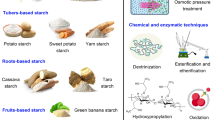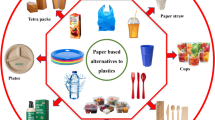Abstract
The fabrication of biodegradable packaging material with active antioxidant capability is an important research area and has gained importance recently. In the present study, biocomposite films were fabricated based on polyvinyl alcohol-corn starch (PVAS) integrated with beetroot stem waste extract (BRS) at 0, 5, 10, 15, and 20% concentrations (w/v). The microstructural characterization, physical and functional properties of the films were evaluated. The incorporation of the extract did not impact the thickness of the films however caused a slight change in the color of the film. FTIR confirmed the intramolecular and intermolecular interactions between the functional groups of PVAS and the BRS. Thermal studies have shown that the incorporation of BRS extract had little effect on the thermal stability of the PVAS films. Field emission scanning electron microscopy (FESEM) study confirms interactions between the bioactive compounds from BRS extract with polyvinyl alcohol-corn starch, which may have enhanced the mechanical properties of films (Tensile strength and elongation at break). The water vapor permeability slightly increased compared to the neat film. The PVAS/BRS20% film has good antioxidant properties compared to neat PVAS film. Developed films demonstrating that they can be used as a packaging material for oxygen-sensitive food products.







Similar content being viewed by others
Data Availability
Research data are not shared.
References
Sanches-Silva A, Costa D, Albuquerque TG et al (2014) Trends in the use of natural antioxidants in active food packaging: a review. Food Addit Contam - Part A Chem Anal Control Expo Risk Assess 31:374–395. https://doi.org/10.1080/19440049.2013.879215
Deshmukh RK, Akhila K, Ramakanth D, Gaikwad KK (2022) Guar gum/carboxymethyl cellulose based antioxidant film incorporated with halloysite nanotubes and litchi shell waste extract for active packaging. Int J Biol Macromol 201:1–13. https://doi.org/10.1016/j.ijbiomac.2021.12.198
Imam SH, Cinelli P, Gordon SH, Chiellini E (2005) Characterization of biodegradable composite films prepared from blends of poly(vinyl alcohol), cornstarch, and lignocellulosic fiber. J Polym Environ 13:47–55. https://doi.org/10.1007/s10924-004-1215-6
Othman N, Azahari NA, Ismail H (2011) Thermal Properties of Polyvinyl Alcohol (PVOH)/Corn Starch Blend Film. undefined
Kumar P, Tanwar R, Gupta V et al (2021) Pineapple peel extract incorporated poly(vinyl alcohol)-corn starch film for active food packaging: preparation, characterization and antioxidant activity. Int J Biol Macromol 187:223–231. https://doi.org/10.1016/J.IJBIOMAC.2021.07.136
Kanatt SR, Rao MS, Chawla SP, Sharma A (2012) Active chitosan-polyvinyl alcohol films with natural extracts. Food Hydrocoll 29:290–297. https://doi.org/10.1016/j.foodhyd.2012.03.005
Gaikwad KK, Singh S, Lee YS (2018) High adsorption of ethylene by alkali-treated halloysite nanotubes for food-packaging applications. Environ Chem Lett 16:1055–1062. https://doi.org/10.1007/s10311-018-0718-7
Gómez-Estaca J, López-de-Dicastillo C, Hernández-Muñoz P et al (2014) Advances in antioxidant active food packaging. Trends Food Sci Technol 35:42–51
Guiné RPF, Gonçalves C, Matos S et al (2018) Modelling through artificial neural networks of the phenolic compounds and antioxidant activity of blueberries. Iran J Chem Chem Eng 37:193–212
Koubaier HBH, Snoussi A, Essaidi I et al (2014) Betalain and phenolic compositions, antioxidant activity of tunisian red beet (Beta vulgaris L. conditiva) roots and stems extracts. Int J Food Prop 17:1934–1945. https://doi.org/10.1080/10942912.2013.772196
Singh S, Gaikwad KK, Lee YS (2018) Antimicrobial and antioxidant properties of polyvinyl alcohol bio composite films containing seaweed extracted cellulose nano-crystal and basil leaves extract. Int J Biol Macromol 107:1879–1887
Kadam AA, Singh S, Gaikwad KK (2021) Chitosan based antioxidant films incorporated with pine needles (Cedrus deodara) extract for active food packaging applications. Food Control 124:107877. https://doi.org/10.1016/J.FOODCONT.2021.107877
Liu Y, Qin Y, Bai R et al (2019) Preparation of pH-sensitive and antioxidant packaging films based on κ-carrageenan and mulberry polyphenolic extract. Int J Biol Macromol 134:993–1001. https://doi.org/10.1016/j.ijbiomac.2019.05.175
Camo J, Lorés A, Djenane D et al (2011) Display life of beef packaged with an antioxidant active film as a function of the concentration of oregano extract. Meat Sci 88:174–178. https://doi.org/10.1016/j.meatsci.2010.12.019
Tanwar R, Gupta V, Kumar P et al (2021) Development and characterization of PVA-starch incorporated with coconut shell extract and sepiolite clay as an antioxidant film for active food packaging applications. Int J Biol Macromol 185:451–461. https://doi.org/10.1016/J.IJBIOMAC.2021.06.179
Kaya M, Ravikumar P, Ilk S et al (2018) Production and characterization of chitosan based edible films from Berberis crataegina’s fruit extract and seed oil. Innov Food Sci Emerg Technol 45:287–297. https://doi.org/10.1016/j.ifset.2017.11.013
Lee S, Zhang M, Wang G et al (2021) Characterization of polyvinyl alcohol/starch composite films incorporated with p-coumaric acid modified chitosan and chitosan nanoparticles: a comparative study. Carbohydr Polym 262:117930. https://doi.org/10.1016/J.CARBPOL.2021.117930
Gaikwad KK, Lee JY, Lee YS (2016) Development of polyvinyl alcohol and apple pomace bio-composite film with antioxidant properties for active food packaging application. J Food Sci Technol 53:1608–1619. https://doi.org/10.1007/S13197-015-2104-9
Popescu MC, Dogaru BI, Goanta M, Timpu D (2018) Structural and morphological evaluation of CNC reinforced PVA/Starch biodegradable films. Int J Biol Macromol 116:385–393. https://doi.org/10.1016/J.IJBIOMAC.2018.05.036
Marszałek K, Krzyżanowska J, Woźniak Ł, Skąpska S (2017) Kinetic modelling of polyphenol oxidase, peroxidase, pectin esterase, polygalacturonase, degradation of the main pigments and polyphenols in beetroot juice during high pressure carbon dioxide treatment. LWT - Food Sci Technol 85:412–417. https://doi.org/10.1016/J.LWT.2016.11.018
Cai Y, Sun M, Corke H (2003) Antioxidant activity of betalains from plants of the Amaranthaceae. J Agric Food Chem 51:2288–2294. https://doi.org/10.1021/jf030045u
Funding
Author would like to sincerely thank the Science and Engineering Research Board (SERB), Government of India, for the financial support provided under the Start-Up Research Grant (SRG) (SRG/2021/001549).
Author information
Authors and Affiliations
Contributions
Princy Kathait: Investigation, formal analysis, visualization, data curation, writing - original draft. PKO: Resources Pardeep Kumar: writing - original draft, manuscript editing, review, formatting KKG: Conceptualization, methodology, resources, manuscript editing and review, supervision, project administration, funding acquisition, revision of manuscript.
Corresponding author
Ethics declarations
Conflict of interest
The authors declare no competing interests.
Additional information
Publisher’s Note
Springer Nature remains neutral with regard to jurisdictional claims in published maps and institutional affiliations.
Rights and permissions
Springer Nature or its licensor (e.g. a society or other partner) holds exclusive rights to this article under a publishing agreement with the author(s) or other rightsholder(s); author self-archiving of the accepted manuscript version of this article is solely governed by the terms of such publishing agreement and applicable law.
About this article
Cite this article
Kathait, P., Omre, P.K., Kumar, P. et al. Development of a PVA-starch Antioxidant Film Incorporating Beetroot Stem Waste Extract for Active Food Packaging. J Polym Environ 31, 4160–4169 (2023). https://doi.org/10.1007/s10924-023-02840-y
Accepted:
Published:
Issue Date:
DOI: https://doi.org/10.1007/s10924-023-02840-y




